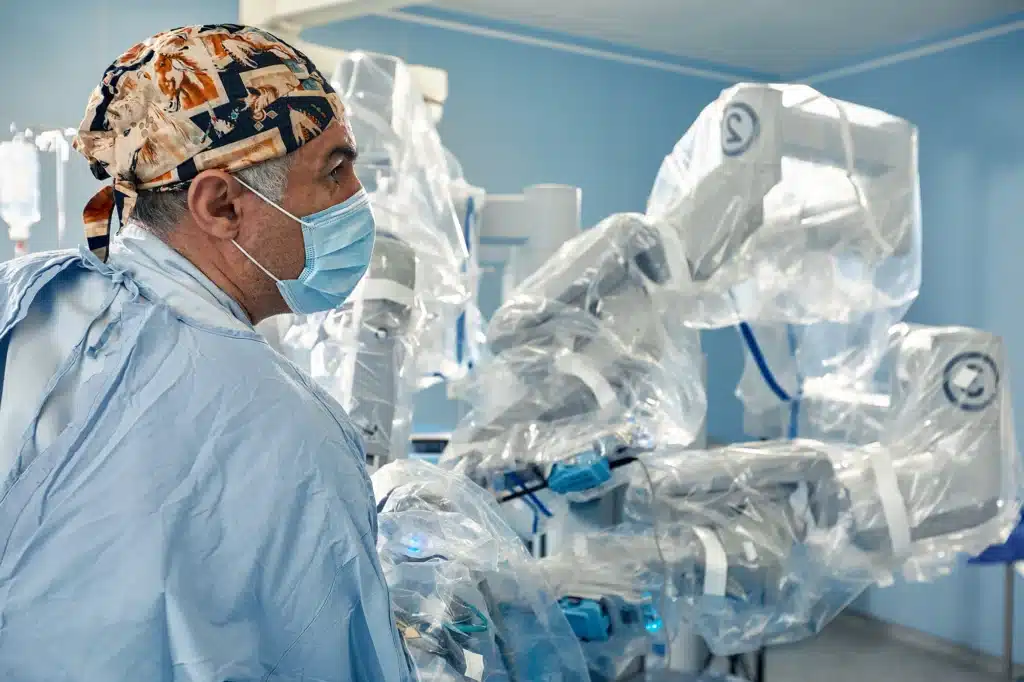
Table of Contents
ToggleBack and neck issues are common problems that bring many patients to seek treatment from specialists. As a spine surgeon with over 30 years of experience in the field, I have seen the evolution of surgical techniques and their impacts on patient outcomes.
Minimally invasive spine surgery vs. traditional spine surgery is a topic of great interest and importance. This blog aims to provide a comprehensive comparison of these two surgical methods, helping you understand the differences, benefits, risks, and what to expect during recovery.
By the end of this article, you should have a clearer idea of which option might be best for you.

Minimally invasive spine surgery (MISS) and traditional spine surgery differ mainly in their approach. Traditional spine surgery involves larger incisions, typically about six inches long, to give surgeons a clear view of the spine.
This method often requires significant muscle retraction, which can lead to more postoperative pain and longer recovery times. On the other hand, MISS uses much smaller incisions, often just a few centimeters, and specialized instruments to minimize muscle and tissue disruption.
This results in less pain, reduced scarring, and quicker recovery times.
The advancements in imaging technology, such as MRI and CT scans, have played a crucial role in the success of MISS. These tools allow for precise targeting of the surgical area, reducing the need for large incisions.
Additionally, MISS often involves the use of tubular retractors and endoscopic cameras, which further minimize tissue damage and enhance the surgeon’s ability to perform delicate procedures.
For a detailed overview of various spine surgery procedures, visit our Spine Surgery: Basics page.
Recovery time is a significant factor for many patients when choosing between minimally invasive spine surgery vs. traditional methods. Traditional spine surgery typically requires a longer hospital stay, often several days to a week, followed by an extended recovery period at home.
Patients might need several weeks or even months before they can return to their normal activities. This prolonged recovery is due to the larger incisions and greater muscle disruption involved in traditional surgery.
In contrast, patients who undergo MISS often experience shorter hospital stays, with many being discharged within one to two days. Some MISS procedures are even performed on an outpatient basis, allowing patients to go home the same day.
The recovery period at home is also shorter, with many patients resuming normal activities within a few weeks. The smaller incisions and reduced muscle damage contribute to less postoperative pain and quicker rehabilitation.
Both minimally invasive spine surgery and traditional spine surgery come with their own sets of risks and complications. Traditional spine surgery carries a higher risk of infection due to the larger incisions and longer exposure time during surgery.
There is also a greater chance of significant blood loss and the need for blood transfusions. Postoperative pain is typically more severe, requiring stronger pain medications and a longer period of pain management.
Minimally invasive spine surgery, while reducing many of these risks, is not without its own complications. One of the primary concerns with MISS is the increased exposure to radiation for both the patient and the surgeon due to the reliance on fluoroscopy during the procedure.
There is also a higher likelihood of requiring a second surgery if the initial minimally invasive approach does not fully address the issue, particularly in complex cases.

The benefits of minimally invasive spine surgery vs. traditional methods are numerous and significant. MISS offers smaller incisions, which means less scarring and reduced risk of infection.
The minimal muscle cutting involved in MISS leads to less postoperative pain and a decreased reliance on pain medications. This, in turn, results in a faster recovery time and a quicker return to normal activities and work.
Another advantage of MISS is the lower risk of complications related to wound healing. Smaller incisions mean fewer opportunities for infection and other wound-related issues.
Additionally, the reduced muscle disruption associated with MISS often results in better long-term outcomes, as the spine’s supporting structures are less compromised.
The choice between minimally invasive spine surgery vs. traditional methods often depends on the specific condition being treated. Conditions like herniated discs, spinal stenosis, and certain types of spinal fractures can be effectively addressed with MISS.
These procedures are particularly beneficial for patients with moderate spinal issues that do not require extensive reconstruction or stabilization.
Traditional spine surgery, however, remains the gold standard for more severe spinal conditions, such as complex spinal deformities, significant spinal instability, or cases where previous surgeries have failed. The ability to visualize the entire spinal structure and make extensive corrections is crucial in these situations, making traditional surgery the preferred approach.

Understanding the recovery process for minimally invasive spine surgery vs. traditional methods is crucial for setting realistic expectations. After traditional spine surgery, patients can expect a longer hospital stay, typically ranging from several days to a week.
The initial recovery phase involves managing significant pain, which often requires strong pain medications. Physical therapy is usually necessary to regain strength and mobility, and it can take several months before patients feel fully recovered.
In contrast, the recovery process for MISS is generally quicker and less painful. Most patients are discharged within a day or two and can manage their pain with over-the-counter medications or mild prescription painkillers.
Physical therapy is still important but tends to be shorter and less intense. Many patients can return to their normal activities within a few weeks, enjoying a faster overall recovery.
To learn more about the recovery process and what to expect, you can also check out this informative article from the Mayo Clinic on Spine Surgery.
When considering minimally invasive spine surgery vs. traditional methods, cost is a significant factor. Traditional spine surgery often incurs higher costs due to the longer hospital stays, increased need for pain management, and more extensive postoperative care.
The use of larger surgical teams and longer operating times also contribute to the higher overall cost.
MISS, on the other hand, can be more cost-effective. The shorter hospital stays and quicker recovery times reduce the overall healthcare costs associated with the procedure. Additionally, many MISS procedures are performed on an outpatient basis, further lowering the costs.
However, it’s important to note that the initial cost of the surgical equipment and advanced imaging technology used in MISS can be higher, but these costs are often offset by the reduced need for extended postoperative care.
Determining the ideal candidates for minimally invasive spine surgery vs. traditional methods involves considering several factors. Generally, younger patients in good overall health are suitable candidates for either type of surgery.
However, MISS is particularly beneficial for older patients or those with comorbidities that make traditional surgery riskier. The reduced surgical trauma and quicker recovery times associated with MISS are advantageous for these patients.
The severity of the spinal condition also plays a role. Patients with moderate spinal issues, such as herniated discs or mild spinal stenosis, are ideal candidates for MISS.
In contrast, those with severe spinal deformities, significant instability, or complex cases requiring extensive correction are better suited for traditional surgery. Previous surgeries and the patient’s overall surgical history are also important considerations when determining the best approach.

The effectiveness of minimally invasive spine surgery vs. traditional methods has been significantly enhanced by technological advancements. Innovations in diagnostic imaging, such as MRI and CT scans, allow for precise targeting of the surgical area, reducing the need for large incisions.
Robotic assistance and advanced surgical instruments enable surgeons to perform complex procedures through small incisions with greater precision and control.
Endoscopic methods have also revolutionized MISS, allowing surgeons to visualize and operate on the spine with minimal tissue disruption. Intraoperative monitoring provides real-time feedback, enhancing the safety and efficacy of the procedures.
These technological advancements have made MISS a viable and often preferable option for many spinal conditions.
Choosing between minimally invasive spine surgery vs. traditional methods should be a carefully considered decision based on the patient’s specific medical conditions and lifestyle. Consulting with a spine specialist is crucial to determine the most appropriate surgical approach.
Factors such as the severity of the condition, overall health, previous surgical history, and recovery goals should all be taken into account.
Patients should also consider their lifestyle and expectations for recovery. Those who lead active lifestyles and require a quick return to normal activities may benefit more from MISS.
On the other hand, patients with more severe conditions or those who require extensive spinal correction may need to opt for traditional surgery despite the longer recovery period.
In conclusion, understanding the differences between minimally invasive spine surgery vs. traditional methods is essential for making an informed decision about your treatment options. Both approaches have their own set of benefits and risks, and the best choice depends on your specific condition and personal preferences.
By consulting with a spine specialist, you can determine the most suitable surgical method for your needs and achieve the best possible outcome for your spine health.
GET IN TOUCH +
285 Sills Road
Building 5-6, Suite E
East Patchogue, NY 11772
(631) 475-5511
184 N. Belle Mead Road
East Setauket, NY 11733
(631) 675-6226
GET IN TOUCH +
285 Sills Road
Building 5-6, Suite E
East Patchogue, NY 11772
(631) 475-5511
184 N. Belle Mead Road
East Setauket, NY 11733
(631) 675-6226
SUBSCRIBE TO OUR NEWSLETTER +
Send us a Google review. Click this link and let us know how we did!
Review us on Yelp too.